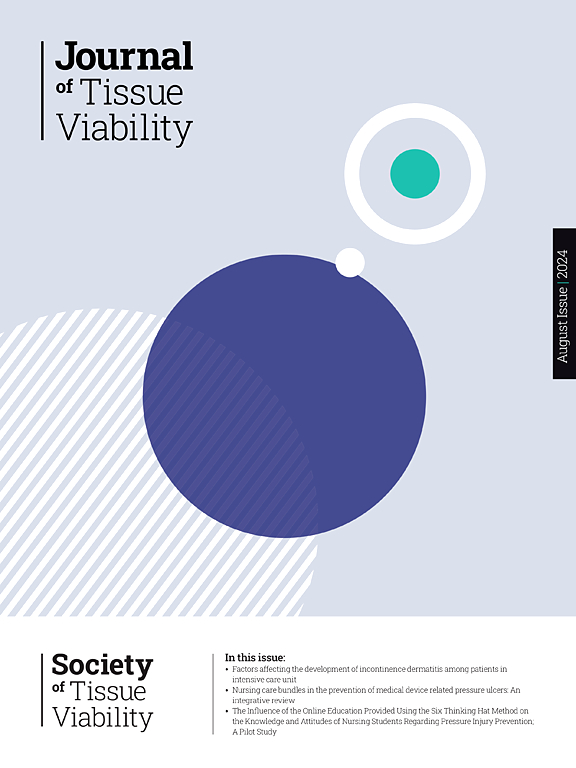新生儿病房中与医疗器械相关的压力损伤发生率及风险因素识别。
IF 2.4
3区 医学
Q2 DERMATOLOGY
引用次数: 0
摘要
目的:本研究旨在调查新生儿重症监护室(NICU)中与医疗器械相关的压力损伤(MDRPIs)的发生率以及影响其发生的风险因素:本研究是一项前瞻性、描述性研究。研究对象为 2022 年 6 月 1 日至 2023 年 6 月 1 日期间的 116 名新生儿。在新生儿重症监护室停留至少 24 小时的新生儿在重症监护室停留期间,每天观察每个医疗设备下方和周围是否存在与医疗设备相关的压力损伤。研究中使用了 "病例报告表"、"MDRPIs监测表"、"儿童布莱登Q量表"、美国国家压力损伤咨询委员会(NPIAP)压力分级和格拉斯哥昏迷量表:与医疗器械相关的压力伤害发生率为 35.3%(41/116)。研究发现,38.1%(16/42)的医疗器械相关压力损伤是由近红外光谱探头造成的,33.5%(14/42)的医疗器械相关压力损伤是由呼吸系统造成的。就解剖位置而言,38.1%发生在前额,23.8%发生在手臂/腿部。研究发现,接受镇静剂和肌注的新生儿在出生体重、胎龄、MDRPIs发生率之间的差异具有统计学意义。回归分析发现,胎龄(p = 0.040,OR = 0.795,95%CI = [0.632-1.000])是发生医疗器械相关压力损伤的独立风险因素:结论:在本研究中,新生儿医疗器械相关压力损伤的发生率相对较高,其中胎龄是 MDRPIs 形成的最重要风险因素。新生儿重症监护护士在提供新生儿护理时必须考虑相关的风险因素,并采取适当的预防措施以降低 MDRPIs 的发生率。本文章由计算机程序翻译,如有差异,请以英文原文为准。
Incidence of medical device-related pressure injuries and identification of risk factors in the neonatal unit
Aim
This study was conducted to investigate the incidence of medical device-related pressure injuries (MDRPIs) and the risk factors influencing their occurrence in the neonatal intensive care unit (NICU).
Method
This study is a prospective, descriptive study. The research was conducted with 116 newborns between June 1, 2022, and June 1, 2023. Newborns who stayed in the neonatal intensive care unit for at least 24 h were observed daily for medical device-related pressure injuries under and around each medical device throughout their stay in the intensive care unit. The "Case Report Form," "MDRPIs Monitoring Form," "Braden Q scale for children," National Pressure Injury Advisory Panel (NPIAP) Pressure Grading, and Glasgow Coma Scale were used in the research.
Results
The incidence of medical device-related pressure injuries is 35.3 % (41/116). It was found that 38.1 % (16/42) of medical device-related pressure injuries developed due to Near-Infrared Spectroscopy (NIRS) probes, and 33.5 % (14/42) developed due to medical devices related to the respiratory system. In terms of anatomical location, 38.1 % occurred on the forehead, and 23.8 % on the arm/leg. The difference between birth weight, gestational age, development of MDRPIs in newborns receiving sedation and inotropes was found to be statistically significant. Regression analysis identified gestational age (p = 0.040, OR = 0.795, 95%CI = [0.632–1.000]) as an independent risk factor for the occurrence of medical device-related pressure injuries.
Conclusions
The incidence of medical device-related pressure injuries in newborns was relatively high in this study, with gestational age being the most significant risk factor for MDRPIs formation. It is crucial for neonatal intensive care nurses to consider associated risk factors while providing newborn care and implement appropriate preventive measures to reduce the incidence of MDRPIs.
求助全文
通过发布文献求助,成功后即可免费获取论文全文。
去求助
来源期刊

Journal of tissue viability
DERMATOLOGY-NURSING
CiteScore
3.80
自引率
16.00%
发文量
110
审稿时长
>12 weeks
期刊介绍:
The Journal of Tissue Viability is the official publication of the Tissue Viability Society and is a quarterly journal concerned with all aspects of the occurrence and treatment of wounds, ulcers and pressure sores including patient care, pain, nutrition, wound healing, research, prevention, mobility, social problems and management.
The Journal particularly encourages papers covering skin and skin wounds but will consider articles that discuss injury in any tissue. Articles that stress the multi-professional nature of tissue viability are especially welcome. We seek to encourage new authors as well as well-established contributors to the field - one aim of the journal is to enable all participants in tissue viability to share information with colleagues.
 求助内容:
求助内容: 应助结果提醒方式:
应助结果提醒方式:


